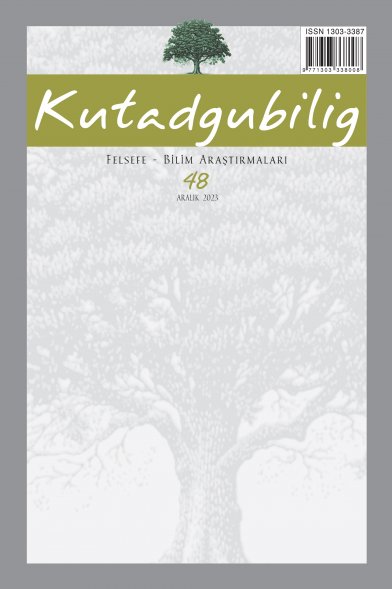GADAMER’DE ÖNYARGILARIN REHABİLİTASYONU
Önyargısız ve varsayımsız bir anlamanın mümkün olmadığını düşünen Gadamer,önyargı ile anlama arasında oluşan döngüselliği insanın temel bir varolmahali olarak sunar. Gadamer için bütün mesele anlamayı her seferinde önceleyenve böylece mümkün kılan önyargıları hermeneutik bir tavırla bilince taşımak veifşa etmektir. Önyargılara ilişkin böylesi bir rehabilitasyon neticesinde, anlamanınhakikatini açan önyargılar ile doğru anlamayı engelleyen önyargılar arasındabir ayrım yapma olanağı ortaya çıkar. Fakat bu süreç, genel olarak bizzat önyargılarınhükmü altında anlayan yorumcunun elinde değil, fakat bir diyalektikdiyalog olarak süregiden tarihin belirlenimindedir. Dolayısıyla yorumcunun görevi,önyargıların rehabilitasyonu aracılığıyla, mümkün olan en sahici şekilde butarihsel diyaloğa dâhil olmaktır. Mevcut çalışmanın amacı önyargıların üstesindengelinemez önceliğinin yanında, tarihin de belirleyici konumunu vurgulayanGadamer’in felsefi hermeneutiğinin içerimlerini ve doğurduğu bazı sonuçlarıserimlemektir.
THE REHABILITATION OF PREJUDICES IN GADAMER
Gadamer suggests that it is not possible to understand without prejudice and presupposition, thus he presents the cyclicality between prejudice and understanding as a basic state of human existence. For Gadamer, the task is to reveal the prejudices that precede, at any moment, our understanding and thus making it possible and to carry them to the consciousness in a hermeneutic manner. As a result of the rehabilitation of prejudices in this manner, there emerges an opportunity to distinguish between the prejudices that open the truth of understanding and the prejudices that prevent true understanding. Yet, this process is not for interpreter to decide, because he is under the influence of prejudices. Rather, the ongoing history as a dialectical dialogue determines this process. Therefore the task of the interpreter is to be involved in this historical dialogue through the rehabilitation of the prejudices, in the most authentic possible way. The aim of the present study is to reveal the implications of Gadamer’s philosophical hermeneutics and results that emanate from it, by emphasizing the insurmountability of the prejudices as well as the determinative position of history.
___
Di Cesare, Donatella; Gadamer: A Philosophical Portrait, çev. Niall Keane, Indianapolis:Indiana University Press, 2007.Dilthey, Wilhelm; “Hermeneutiğin Doğuşu”, Hermeneutik ve Tin Bilimleri, çev. Doğan Özlem, s.83-119.İstanbul: Paradigma Yayınları, 1999.
Dilthey, Wilhelm; Der Aufbau der geschichtlichen Welt in den Geistwissenschaften, Frankfurt am Main: Suhrkamp Verlag, 1981.
Feher, Istvan M.; “Prejudice and Pre-Understanding”, The Blackwell Companion to Hermeneutics, ed. Niall Keane ve Chris Lawn, s.280-286, Sussex: Willey Blackwell, 2016.
Gadamer, Hans-Georg; Wahrheit und Methode, GW1, Tübingen: Mohr Siebeck Verlag, 2010.
Gadamer, Hans-Georg; “Die Universalität des Hermeneutischen Problems”, Hermeneutik II Wahrheit und Methode, GW 2, s. 219-231, Tübingen: Mohr Siebeck Verlag, 1993.
Gadamer, Hans-Georg; “Vom Zirkel der Verstehens” Hermeneutik II Wahrheit und Methode, GW 2, s. 57- 65, Tübingen: Mohr Siebeck Verlag, 1993. Grondin, Jean; “The Hermeneutic Circle”, The Blackwell Companion to Hermeneutics, ed. Niall Keane ve Chris Lawn, s.299-304, Sussex: Willey Blackwell, 2016.
Gadamer, Hans-Georg; Einführung in die Philosophische Hermeneutik, Darmstadt: Wissenschaftliche Buchgesellschaft, 2001.
Heidegger, Martin; Sein und Zeit, Tübingen: Max Niyemeyer Verlag, 2006. Plato; “Meno”, Plato: Complete Works, çev. G.M.A Grube, ed. John M. Cooper, Cambridge: Hackett Publishing, 1997.
Schleiermacher, Friedrich; Hermeneutik und Kritik, Frankfurt am Main: Suhrkamp Verlag 2011.
Warnke, Georgia; “The Hermeneutic Circle Versus Dialogue”, The Review of Metaphysics, Vol. 65 No:1, s.91-112, 2011.
- ISSN: 1303-3387
- Yayın Aralığı: Yılda 2 Sayı
- Başlangıç: 2002
- Yayıncı: Dergah Yayınları A.Ş.
Sayıdaki Diğer Makaleler
OSMANLI MANTIK GELENEĞİNDE ÎSÂGÛCÎ ÖRNEĞİ: KISM-I TASAVVURÂT MİN HÜLÂSATİ’L-MÎZÂN
GÜZEL VE YÜCE: PİSAGOR’DAN HEGEL’E ESTETİK KÜLTÜRÜ
FAHREDDİN ER-RÂZÎ’NİN ‘DİLDE KESİNLİK’ SORUNUNA YAKLAŞIMI: TESPİT VE TERCİH
Mehdi CENGİZ, Şükran FAZLIOĞLU
HAYATIN ANATOMİSİ/CANLILAR BİLİMİ FELSEFESİ- EVRİM VE ÖTESİ
MODERN BİLİMİN SOSYOEKONOMİK TEMELLERİ ÜZERİNE HESSEN-GROSSMAN TEZİNE DAYALI BİR İNCELEME
GADAMER’DE ÖNYARGILARIN REHABİLİTASYONU
KOPERNİK DEVRİMİ: MODERN KOZMOLOJİNİN OLUŞUM SÜRECİ
